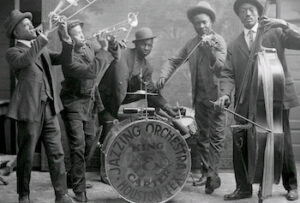
*Ragtime music is celebrated on this date in 1895. Ragtime is a musical style that peaked from the 1890s to the 1910s. Its cardinal feature is its syncopated or "ragged" rhythm.
Ragtime music originated within African communities in the United States in the late 19th century and became a distinctly American form of popular music. It is closely related to marches. Ragtime music existed long before it was printed as sheet music. While its origins are unknown, scholars like Terry Waldo believe it stems from music played by American plantation slaves for dances called "rags" (these were mentioned in newspaper articles as early as the 1820s).
While no examples of music from this era survive, some examples exist before ragtime's heyday in the 1890s. Believed to be one of the oldest preserved pieces of ragtime music is The Dream Rag (titled initially The Bull Dyke's Dream) by Jessie Pickett. While its year of composition is unknown, Eubie Blake (who Pickett taught it to around 1900) believed it was written before the American Civil War. Unlike the march-style left-hand pattern of many later rags, The Dream Rag uses a rhythm more closely related to the habanera, providing a good example of how Spanish music influenced the ragtime genre. Jesse Pickett performed The Dream Rag at the 1893 Chicago World's Fair, where the greater American public was first introduced to what would become known as ragtime.
The music group was a banjo player and a fiddle player. They would play dance music like jigs, reels, and schottisches, and how the banjo is played provides the rhythm that ragtime came to be known for. The first ragtime composition to be published was "La Pas Ma La" in 1895. Black minstrel comedian Ernest Hogan wrote it with Kentucky native Ben Harney. While the word ragtime was first used in 1896, the term probably originates in the dance events hosted by plantation slaves known as "rags." The first recorded use of the term ragtime was by vaudeville musician Ben Harney, who in 1896 used it to describe the piano music he played (which he had taken from Black banjo and fiddle players).
Ragtime pieces usually contain several distinct themes, often arranged in patterns of repeats and reprises. Ragtime influenced early jazz, Harlem stride piano, Piedmont blues, and European classical composers such as Erik Satie, Claude Debussy, and Igor Stravinsky. Ragtime was popularized during the early 20th century by composers such as Scott Joplin, James Scott, Shep Edmonds, William Tyers, and Joseph Lamb. Another surviving example of early ragtime is the music of Louis Moreau Gottschalk. While not a ragtime composer per se, there are elements in his music that are distinctly reminiscent of the genre. Ragtime pieces (often called "rags") are typically composed for and performed on piano, though the genre has been adapted for various instruments and styles.
Despite being overshadowed by jazz in the 1920s, ragtime has experienced several revivals, notably in the 1950s and 1970s. The music was distributed primarily through sheet music and piano rolls, with some compositions adapted for other instruments and ensembles. The composed ragtime of the 1890s originated in Black communities of the Mississippi Valley and St. Louis in particular. Most early ragtime musicians could not read or notate music; instead, they played by ear and improvised. It was performed in brothels, bars, saloons, and informal gatherings at house parties or juke joints. These places were an excellent breeding ground for new music as white European classical music was mixed with African American folk songs.
To Become a musician or Singer
To Become a Conductor or Composer